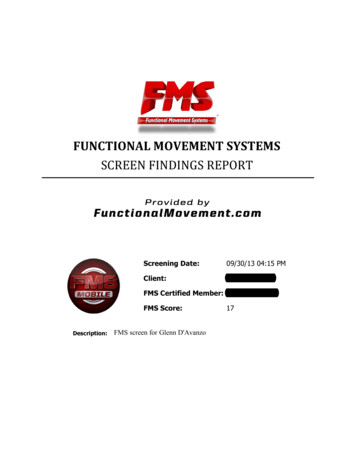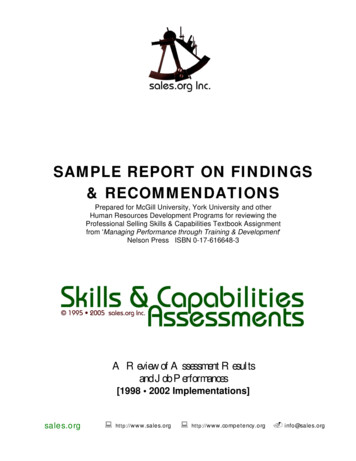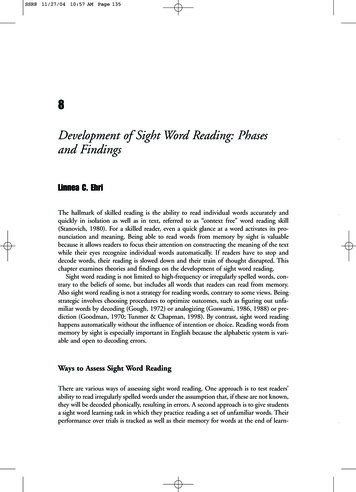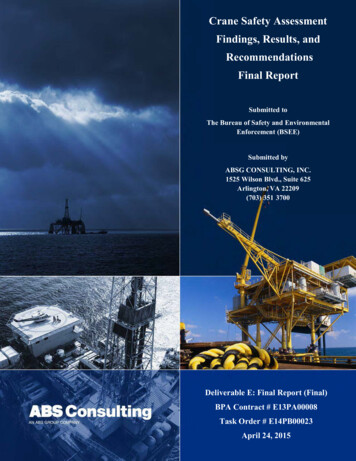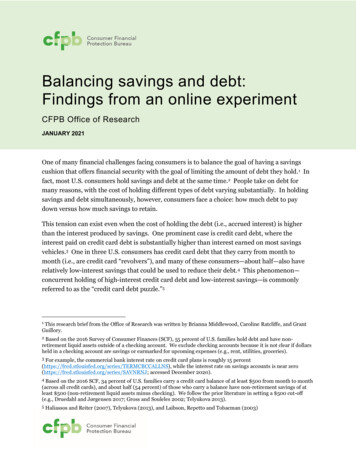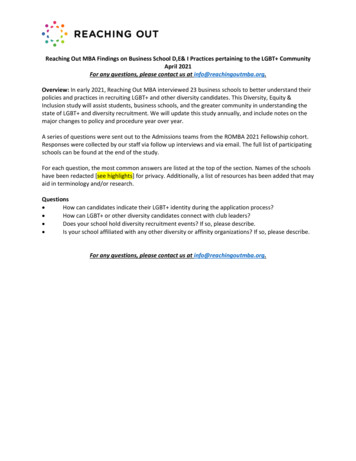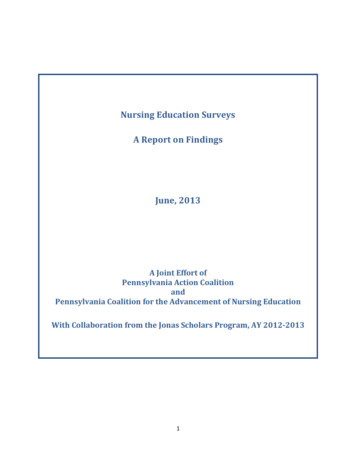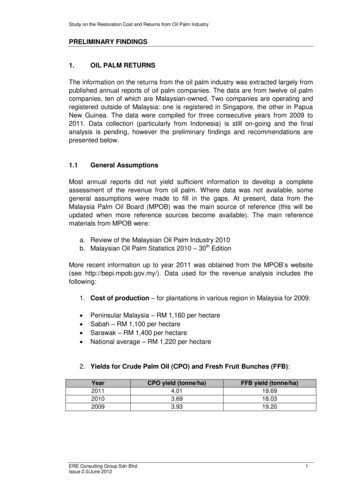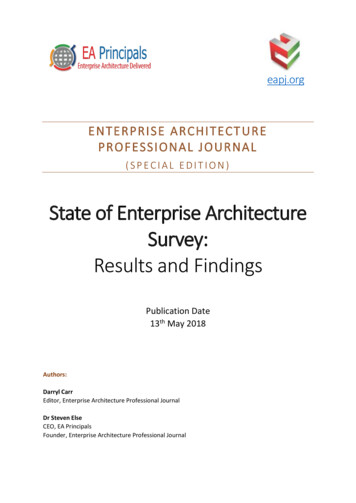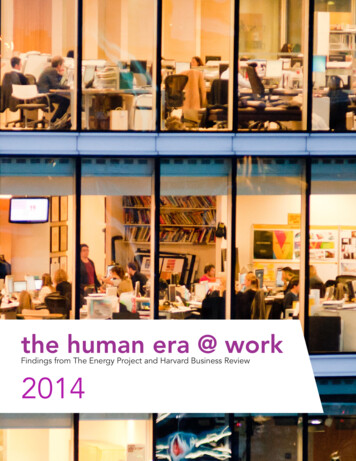
Transcription
the human era @ workFindings from The Energy Project and Harvard Business Review20141
table of contentsreinventing the workplace: a note from Tony Schwartz.2meeting people’s four core needs at work.4the findings: physical.6the findings: emotional.7the findings: mental.8the findings: spiritual.9leaders at work.10conclusion.12about The Energy Project.13about the survey.14respondent profile.15sources.17
reinventing the workplace:a note from Tony SchwartzIt’s a depressing butundeniable reality:the vast majorityof employeesfeel depleted,diminished,disenfranchised,demoralized, anddisengaged at work.that people ought to be able to operate in thesame way.The problem is we can’t. Unlike machines, humanbeings are designed to pulse regularly betweenspending and renewing energy. While machinescan run on one source of energy, people havefour core energy needs: physical, emotional,mental, and spiritual. It’s time to usher in theHuman Era at work. In the Human Era, leaderstake better care of their people, so people cantake better care of their business.And it’s gettingworse. In a world ofrelentlessly risingdemand and complexity, the great unsolvedpuzzle of the modern workplace is how to tapinto more of people’s potential so they canperform sustainably at their best.In today’s knowledge-driven economy, thebest measure of productivity is no longer howmuch time people invest. Rather, it’s how muchenergy they bring to whatever hours they work- and the value of the work they produce as aconsequence. The challenge for employers is tofree, fuel, and inspire their employees to bringmore of their potential to work every day.Here’s the conundrum: how people perform isinextricably connected to how they feel, butinterior life remains terra incognita in mostcompanies. The unspoken expectation is thatemployees will set aside their needs in order toget their work done.Paradoxically, getting more out of peopledepends first and foremost on investingmore in them. That’s the primary lesson TheEnergy Project team has learned in workingwith thousands of people, across dozens ofcompanies, during the past decade.We’ve valued people for what they can produce,but paid very little attention to what it takes tobe sustainably productive. Instead, for 200 years,since the dawn of the Industrial Age, the modelfor how to work has been the machine, andmore recently, the computer. More, bigger, fasterremains the prevailing mantra.It’s also the overwhelming message from thenearly 20,000 people we surveyed during thepast year about their experience in the modernworkplace. The better people’s needs are met,the more healthy, happy, engaged, productive,and loyal they become. Take care of them, andthey’ll take care of business.Machines are valued for their speed, efficiency,and predictability. They make no demands.When they break, they can be repaired orreplaced. Computers run even faster and domore. The assumption in organizations has been2
Most companiesare failing to meetthe needs of theiremployees.3
meeting people’s four core needs at workIn partnership with the Harvard BusinessReview, The Energy Project set out last fallto assess the factors that most influence howpeople feel at work, and how they perform as aresult. What emerged from The Quality of Life@ Work study of 20,000 employees in dozensof countries around the world is that they havefour predictable core needs at work: physically,to rest and renew; emotionally, to feel caredfor and valued; mentally, to be empowered toset boundaries and focus in an absorbed way;and spiritually, to find a sense of meaning andpurpose in their work.Only 7% of people have their core needsmet at work.8%7%NO12%14%Since the dawn of capitalism, time for moneyhas been the core value exchange betweenemployees and their employers. It no longerserves either party well. Paying for people’stime is no guarantee you’ll also get theirenergy, engagement, focus, or passion.Conversely, no amount7%of money people getpaid is sufficient 8%to meet their core needs.T59%No Core Needs MetOne Core Need MetFor much of12%the past two decades, the keyfactor associated with higher performance has59%been engagement. More than 200studies14% a direct and powerfulhave now confirmedrelationship between the level of employeeengagement and company performance. In its2012 Global Workforce Study, Towers Watsonfound that companies with the lowest levelof engagement had an average operatingmargin of 10%. Those with traditionally highengagement scores had a margin of 14%.1Two Core Needs MetThree Core Needs MetFour Core Needs Metsource: November 2013 – June 2014, What Is Your Quality Of Life @ Work? HBR.org & The Energy Project (n 19,900 )most engaged employees are running on empty.The Towers Watson study found that “sustainablyengaged” employees - those who have not onlythe willingness but also the physical, emotional,and social energy to invest that extra effort have operating margins almost double thoseof traditionally engaged employees.2 Our ownresearch suggests that it’s equally critical toactively promote mental and spiritual well-being.Engagement has traditionally been definedas “the willingness to expend discretionaryeffort on the job.” But willing, it turns out,is no longer a guarantee of able. With theincreased demands created by technology anda more complex global economy, even the4TF
The Human Era calls for a new kind of leader,whose most fundamental role is to serve as ChiefEnergy Officers, responsible for mobilizing,focusing, inspiring, and regularly recharging theenergy of those they lead.In the physical dimension, that means ensuringthat team members effectively balance intenseeffort with real renewal, not only in the evenings,on the weekends, and during vacations, but alsointermittently throughout the workday.Emotionally, the charge to leaders is to trulycare for those they lead – not just by regularlyrecognizing and appreciating them for theiraccomplishments, but also by holding theirvalue while delivering critical feedback, and bybelieving in their capacity to exceed their ownexpectations.Mentally, effective leaders create an environmentin which employees are empowered to set clearpriorities and firm boundaries, so they’re able tofocus in an absorbed way on immediate, tacticalwork, to take sacrosanct time for creative andstrategic thinking, and to work flexibly, in waysthat best suit their needs.Finally, in the spiritual dimension, the bestleaders define a clear and compelling vision anda set of values that inspire team members – whileserving themselves as role models who walk theirtalk.many companies are failing to meet the needs of their employeesEmployeesIdentify Theirmany companiesareUnmetfailingNeedsto meettheorneedsof their employees5050%Time for onemore breaks40Ability to balance work and home life51%Time for more than one break40Ability to disengage from work43Ability to balance work and home life49A sense of community43Ability to disengage from work45Overall positive energy55Opportunities to do what is most enjoyed40Comfort in truly being yourself52A sense of community70Regular time for creative or strategic thinking51Opportunities to do what you do best3749%423435403630453318336648Ability to focus on one thing at a timeOverall positive energy21336044Opportunities to do what is most enjoyedComfort in truly being yourself33414872Opportunities for learning and growthRegular time for creative or strategic thinking38164768Opportunities to do what you do bestAbility to focus on one thing at a time36194652Ability to prioritize your tasksOpportunities for learning and growth363543504048405554physicalphysical* neutral answers have been omittedUnderstanding of how to be successfulAbility to prioritize your tasksLevel of meaning and significanceUnderstanding of how to be successfulConnection to your company’s missionLevel of meaning and significanceConnection to your company’s missionemotionalemotionalsource: November 2013 – June 2014, What Is Your Quality Of Life @ Work? HBR.org & The Energy Project (n 19,900 )mentalmental40344237453234spiritualspiritual
the findings: physicalThe key need in this dimension, and often theleast valued in modern organizations, is renewal.Unlike machines, human beings are designedto pulse – meaning to move rhythmicallybetween work and rest. Four critical behaviorsserve renewal: sleep, daytime rest, fitness, andnutrition.3how many people take breaksbreakevery 90minutes9% Daytime rest: The work of Nathaniel Kleitmandemonstrates that the human body moves in90-minute ultradian cycles throughout the day,during which we move from higher to loweralertness. 4one orfewerbreaks51%morethan onebreak40%Unfortunately, the Quality of Life @ Work Studyfound that only 49% of employees take morethan one break during the day. Those who takeat least a brief break every 90 minutes reporteda 28% higher level of focus than those whotake just one break, or no breaks at all.employees who take a break every90 minutes report:These employees also reported a 40%greater capacity to think creatively and a 30%higher level of health and well-being. Feelingencouraged by one’s supervisor to take breaksincreases peoples’ likelihood to stay with thecompany by 81%, and also increases theirsense of health and well-being by 78%.40%greater ability to thinkcreatively30%Employees who work at least 55 hours,compared to those who work 40 hours or less,report feeling 21% less engaged and 27% lessfocused.higher level of health andwell-being28%better focussource: November 2013 – June 2014, What Is Your Quality Of Life @ Work? HBR.org & The Energy Project (n 19,900 )6
the findings: emotionalOnce people’s physical needs are met, the nextorganizational challenge is to fuel emotionalenergy. How people feel profoundly influenceshow they perform. Very specific emotions areassociated with high performance, and they canbe actively and intentionally cultivated.hear. Respondents who felt they didn’t receiveuseful, digestible feedback reported 34% lowerengagement, 33% less focus, and a 47% lowerlikelihood to stay with the organization.Our study uncovered two critical variables forfueling emotional energy: a feeling of enjoymentand satisfaction, and a sense of safety and trust.how many people are satisfied intheir job Enjoyment and Satisfaction: Only 37% ofrespondents said they were satisfied in theirjobs, but those who did reported being 54%more able to focus and 2.3 times as engaged.Only 30% of respondents said they had theopportunity to do what they enjoy most atwork, and those who didn’t reported being38% less focused, 49% less engaged, and 57%less likely to stay with the organization.satisfied37% Safety and Trust: Only 29% of respondentsfeel a sense of safety and trust at work;only 25% of respondents feel they can givetheir leader honest feedback; and only 21%reported receiving feedback in a way they candissatisfied46%neutral17%feeling satisfaction with one’s job isassociated with:125%greater engagement54%better focussource: November 2013 – June 2014, What Is Your Quality Of Life @ Work? HBR.org & The Energy Project (n 19,900 )7
the findings: mentalFocus and prioritization are a primary source ofpain in organizations today, and technology isthe primary cause. Never before have we beensubjected to so much incoming information,so continuously, and with so much expectationto respond instantly.Those who were able to effectively prioritizereported being 48% more engaged and 89%more likely to stay with their organization.In a much-cited study, Gloria Mark, aresearcher at the University of California,Irvine, looked at workers at two high-tech firmsand found that on average, they spent elevenminutes on any given project, during whichthey spent only an average of 3 minutes pertask.4 At the same time, the researcher DavidMeyer has found that when human beingsjuggle multiple tasks, it takes significantlylonger to finish each of them.5how many people are e Energy Project’s study backed up bothof these findings. Very few respondents saidthey are able to focus in an absorbed wayon their highest priorities, but those who canexperience a variety of positive performanceeffects. Focus: While only 19% of respondents saidthey were able to consistently focus theirattention on one thing at a time, thosewith the highest level of focus reportedbeing 29% more engaged. Only 16% ofrespondents said they regularly allocatedtime for creative and strategic thinking,the lowest number for any behavior inour survey. Those who allocate such timeare 83% more likely to stay with theirorganization.can't focus68%the highest level of focus isassociated with:29%greater engagementsource: November 2013 – June 2014, What Is Your Quality Of Life @ Work? HBR.org & The Energy Project (n 19,900 ) Prioritization: Only slightly more than1/3 of respondents said they were able toeffectively prioritize their tasks, and less thana quarter of them said their own leaders setclear priorities and stayed focused on them.8
the findings: spiritual Meaning: Deriving a sense of meaning andsignificance from their work had the highestsingle impact of any variable in the survey.Employees who did find meaning in theirwork also reported being 2.8 times morelikely to stay with their organization, 2.2 timesmore satisfied with their jobs, and 93% moreengaged.No single factor in the study influences people’sjob satisfaction and likelihood to stay at anorganization as much as feeling connected totheir company’s mission, and finding a sense ofmeaning and purpose in their work. Mission: Most companies fall far shortof communicating their mission to theiremployees in a clear and compelling way.Only 34% of respondents said that they felt aconnection to their company’s mission, andthose who didn’t feel such a connection were62% less likely to stay with their employers and45% less engaged.how many people derive a highlevel of meaning from workdo36%don't50%neutral14%deriving a higher level of meaningfrom work is associated with:93%greater engagement177%greater likelihood to staywith the organizationsource: November 2013 – June 2014, What Is Your Quality Of Life @ Work? HBR.org & The Energy Project (n 19,900 )9
leaders at workLeadership behaviors in every dimension havea significant impact on employee energy,sustainability, and performance.Physical: To fuel the highest levels ofperformance in the physical dimension, leadersmust both encourage and model sustainablework behaviors. For example, more and morecompanies are building fitness facilities and evennap rooms but when leaders don’t make use ofthem, employees are understandably reluctant todo so themselves. The result is that many wellequipped gyms sit largely unused during workhours. Perks that ought to be generating positiveenergy and renewal among employees can endup instead prompting frustration and resentment.Only 17% of respondents in our survey reportedhaving a leader who encouraged them to takeregular renewal breaks throughout the day. Thosewho did, reported being 40% more engaged,54% more satisfied with their jobs, 51% moreable to prioritize, and 81% more likely to stay withtheir organization.Emotional: For leaders, the key to fuelingemotional energy is to be optimistic and positive,and to consistently make team members feelvalued, respected, and appreciated.The three leadershipcharacteristics that hadthe biggest impact on allperformance variables were 1)treating employees with respect,2) recognizing and appreciatingthem, and 3) being positive andoptimistic.Treating employees with respect has a biggerimpact on their sense of safety and trust, andtheir ability to focus, than any other leaderbehavior. Employees who felt their leaderstreated them with respect were 63% moresatisfied with their jobs, 55% more engaged, 58%more focused, and 110% more likely to stay withtheir organization. Those who felt recognized and10
appreciated by their leader reported 53% higherfocus, 58% higher engagement, and a 109%higher likelihood to stay with the organization.Leaders perceived as positive and optimistichave a contagious impact on their employees.Employees with positive leaders reported 54%higher engagment, 71% more enjoyment atwork, 2.5 times more trust and safety, and a 105%higher likelihood to stay at the organization.They also report 2.2 times the level of meaningand significance at work, and 55% more focus,suggesting how profoundly positive behaviors inone domain have a spillover effect into others.Mental: In the mental dimension, as in alldimensions, leaders must focus on bothmodeling and support. For example, if leadersregularly send out emails in the evenings andover the weekends, it’s a near guarantee thattheir direct reports will feel compelled to readand respond to them. Even when leaders saythey don’t expect responses on weekends, theirbehavior speaks louder than their words.engaged, and 100% more likely to stay with theirorganizations.Leaders set the tone for the energy of their teammembers. If they model positive practices, itincreases the likelihood that their team memberswill follow suit. When leaders actively supportmore sustainable ways of working, the result is asignificant positive impact on every performancevariable.Only 21% of our surveyrespondents told us that theirleaders model sustainable workpractices.Employees who work for these leaders are 51%more engaged, 68% more satisfied at work, and100% more likely to stay at the company.A comparable problem occurs when leadershave the expectation - explicit or unspoken - thatemployees will respond immediately to emailssent during the workday. The consequence isthat employees are repeatedly distracted fromtheir ongoing work. Sure enough, only 19% ofour respondents said they were regularly able tofocus on one thing at a time, and only 16% saidthey allocated sacrosanct time to creative andstrategic thinking.Spiritual: Purposeful leaders have an especiallypowerful influence on their employees. Only20% of employees reported having a leader whocommunicates a vision that is clear, consistent,and inspiring. Those that did reported being70% more satisfied with their jobs, 56% more11
how meeting core needs affects employeesThe more needs employers meet— physical, emotional, mental, and spiritual— the more theirpeople’s performance variables improve.number of needs met compared to none1 91% 75% 81%324 126%increasesengagement 106% 89% 50% 59%Positive energy at workmore than doubles whenemployees have at leastthree core needs met.Meeting one core needincreases engagementby 50%. 199% 169% 148% 100%increasespositive energyat work 77%buildsemployeeloyalty 66% 56%increases lifesatisfaction 42%Employees’ lifesatisfaction steadilyincreases as more coreneeds are met.Employees’ retentiondoubles when just onecore need is met.source: November 2013 – June 2014, What is your quality of life at work? HBR.org & The Energy Project (n 19,900 )Workers at all levels in our survey are sending employers a clear message. If sustainable highperformance is the goal, don’t seek to get more out of us. Rather, invest more in helping to meet ourcore needs, so we have the energy we need to tap our full potential.It’s a new value proposition: Take better care of us and we’ll take better care of business.12
abo
spending and renewing energy. While machines can run on one source of energy, people have four core energy needs: physical, emotional, mental, and spiritual. It’s time to usher in the Human Era at work. In the Human Era, leaders take better care of their people, so people
